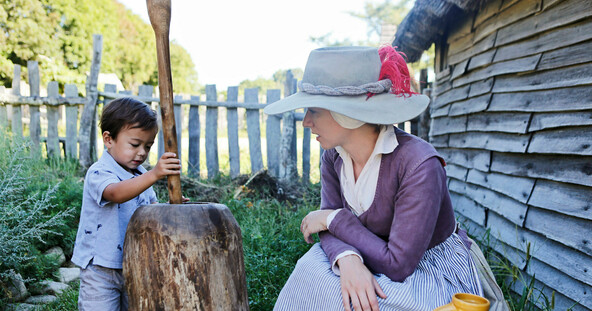
What to Expect
How to Have a Great Time at Plimoth Patuxet Museums
Ask questions!
We know that for some people, asking questions in our historical sites can sometimes feel a little intimidating. We understand that you might be feeling shy or awkward about asking questions. Our interpreters will do their best to talk to you first, but we encourage you to jump in and begin a conversation. Our interpreters are expecting you to ask them about all the things you're interested in. Here are some helpful tips for asking questions at the different sites:
17th-Century English Village
The people you will meet are living in the year 1627. They don't know anything beyond that year. (You may ask modern questions at other places in the Museum.)
Sample Questions:
- "What ship did you arrive on?"
- "How do you get your food?"
- "What sort of work does an 8 year old girl do?"
- "Why did you want to leave England?"
- "Do English children go to school?"
Historic Patuxet
You will be meeting modern-day Native People, some are Wampanoag, some are from other Native Nations. At this site contemporary interpreters discuss the 17th-century life-ways of a culture that continues to thrive today.
Sample Questions:
- "How long have the Wampanoag People been living here?"
- "What does 'Wampanoag' mean?"
- "What Native Nation are you from?"
- "What did Wampanoag children do for fun?"
- "Did Wampanoag children go to school in the 1600s?"
The Parents' Guide
The following are some fun ways to focus your children during their visit to the outdoor sites of the Museum.
Have the children imagine what it would be like to live in the 17th-Century English Village, on board Mayflower II or at Historic Patuxet. Where would their food come from? What about their clothing? What might they do for work and for play?
When you first enter Historic Patuxet and the 17th-Century English Village, pause to look at the way the houses are made. Have your children note the differences in the 17th-century houses from your own home or neighborhood. Find out from what materials these houses are made. Ask what tools were used to build these houses.
Have children look for objects the English or Wampanoag used in their daily lives. Try to find out what these objects were used for and how they were made. Then compare them to objects we use for the same purpose today. If you have paper and a pencil, they can make a sketch of an object.
Take a moment to have your children close their eyes and identify the many smells and sounds they are encountering. Do this periodically as you travel through the museum sites. How do the sounds and smells change at different places in the museum? Do you have those smells/sounds at home? Why or why not?
At Historic Patuxet, the 17th-Century English Village or Mayflower II, have your children find out how to make a common food item that people ate in the 17th century. Write down the ingredients and how it was made. How would you make it at home? Do you eat anything like it already?
Please, no costumes of any kind.
Regalia, or the traditional clothing, accessories, and creations worn by Indigenous peoples during special events today, should only be worn by Indigenous peoples. Regalia are deeply symbolic, significant, and often sacred garments that can convey the status, heritage, and cultural identity of the wearer. Creating and designing regalia is an important process and maintains connection with the land, waterways, and life that calls them home. When a non-Indigenous person wears regalia, it is cultural appropriation. We ask that you approach your time at this Museum, and with Indigenous staff who may be wearing modern clothing, with respect. In that interest, the Museum does not allow or support the use of guests wearing regalia as 'costumes'.